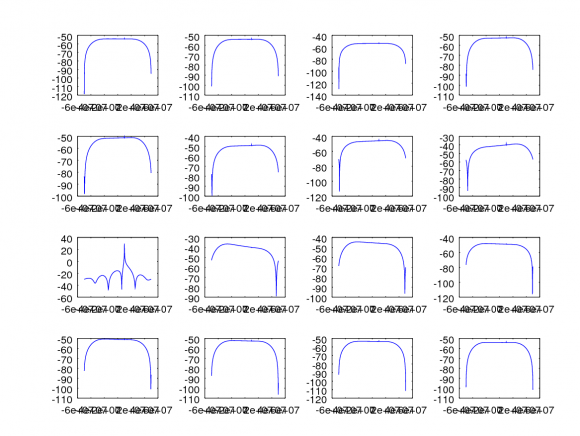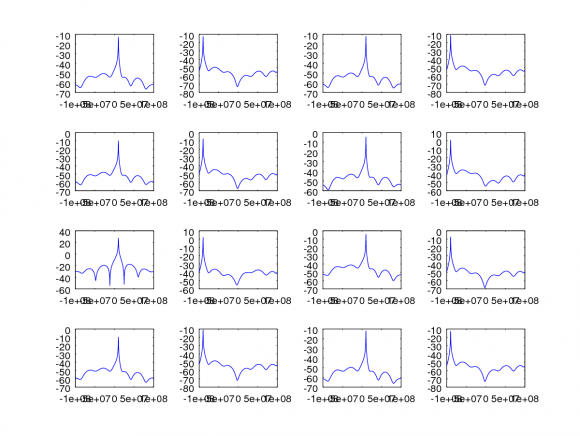M-to-2 Polyphase Decimation Channelizer
clear all;close all; clc;
chans = 16;
chan_inject = 0.1;
Fs = 100e6;
NSamp = 10e3;
NFFT = 2.^floor(log2(NSamp));
data_in = single_tone_data(Fs/chans*chan_inject, Fs, NSamp);
%% M-to-1 Decimation Channelizer
%{
f1 = Fs / chans * 0.6;
f2 = Fs / chans * 0.8;
f3 = Fs / chans * 1.0;
delta_f = f3 - f1;
dB = 100;
N = dB * Fs / (22 * delta_f);
hc = fir2((round(N / chans) * chans) - 1, [0 f1/Fs f2/Fs f3/Fs 1], [1 1 1/2 0 0]);
dataBank = flipud(reshape(data_in, chans, floor(size(data_in, 2) / chans)));
coeffBank = reshape(hc, chans, size(hc, 2)/chans);
data_out = zeros(size(dataBank));
for rowIdx = 1:chans
data_out(rowIdx,:) = filter(coeffBank(rowIdx,:), 1, dataBank(rowIdx,:));
endfor
for colIdx = 1:size(data_out, 2)
data_out(:,colIdx) = fftshift(ifft(data_out(:,colIdx)));
endfor
figure
fDisp = (-NFFT/chans/2:NFFT/chans/2 - 1) * Fs / (NFFT/chans);
for rowIdx = 1:chans
subplot(ceil(sqrt(chans)),ceil(sqrt(chans)),rowIdx)
dis = 20*log10(abs(fftshift(fft(data_out(rowIdx,:), NFFT/chans))));
plot(fDisp,dis);
endfor
%}
%% M-to-2 Decimation Channelizer
%%{
f1 = Fs / chans * 0.6;
f2 = Fs / chans * 0.8;
f3 = Fs / chans * 1.0;
delta_f = f3 - f1;
dB = 100;
N = dB * Fs / (22 * delta_f);
hc = fir2((round(N / chans) * chans) - 1, [0 f1/Fs f2/Fs f3/Fs 1], [1 1 1/2 0 0]);
dataBank = flipud(reshape(data_in, chans/2, size(data_in, 2)/chans*2));
dataBank = [dataBank;[zeros(chans/2, 1) dataBank(:,1:end-1)]];
coeffBank = reshape(hc, chans, size(hc, 2)/chans);
data_out = zeros(size(dataBank));
for rowIdx = 1:chans
data_out(rowIdx,:) = filter(coeffBank(rowIdx,:), 1, dataBank(rowIdx,:));
endfor
for colIdx = 1:size(data_out, 2)
if mod(colIdx, 2) == 1
data_out(:,colIdx) = fftshift(ifft(data_out(:,colIdx)));
else
data_out(:,colIdx) = fftshift(ifft([data_out(end/2+1:end,colIdx);data_out(1:end/2,colIdx)]));
endif
endfor
figure
fDisp = (-NFFT/chans/2:NFFT/chans/2 - 1) * Fs * 2 / (NFFT/chans);
for rowIdx = 1:chans
subplot(ceil(sqrt(chans)),ceil(sqrt(chans)),rowIdx)
dis = 20*log10(abs(fftshift(fft(data_out(rowIdx,:), NFFT/chans))));
plot(fDisp,dis);
endfor
%}
M-to-1 Output:

M-to-2 Output:


here is an example of a 6-to-1 i implemented a while back where h1a is my FIR filter, and x is my input sequence. You're code was a little convoluted so i didnt sift through it but maybe this will shed some light on stuff.
h1apoly=6∗reshape(h1a ,6 ,length( h1a ) / 6 ) ;
regsa=zeros ( 6 , length(h1a) / 6 ) ;
v1= 0 ;
vv = 0 ;
n2=1;
for n = 1:6:length(x)−5
v1 = fliplr ( x(n:n + 5) ) ’;
regsa = [ v1 regsa(: , 1:size(h1apoly ,2) −1)] ;
for k=1:6
vv (k)= regsa(k ,:) ∗ h1apoly (k , :) ’ ;
end
yy(:, n2)= ifft(vv) ’ ;
n2=n2+1;
end
Spetcavich,
Thanks for the info. Looking at what you have, you are breaking your FDM signal into 6 channels, each at a sample rate of Fs/6. I have this, where the output sample rate of each channel is the sample rate divided by the number of channels. Where I am having issues is where the output sample rate of each channel is 2 * Fs / N, where N is the number of channels. From what I have read around, the structure and data packing is a little different. This, or the values of my prototype filter, are where I believe I am having issues.
Michael

http://sdsu-dspace.calstate.edu/bitstream/handle/1...
also not sure you should have zeros packed into your data vector like this, not sure what is going on here:
dataBank = [dataBank;[zeros(chans/2, 1) dataBank(:,1:end-1)]];
Example: h1bpoly=6∗reshape( h1b , 6 , length ( h1b ) / 6 ) ; regb=zeros(6 , 2∗length(h1b)/6 ) ; n2=1; flg =0; %process for n = 1:3:length(x)−2 v1b (1:3) = fliplr( x(n:n+2) ) '; v1b (4:6) = v1b ( 1 : 3 ) ; regb = [v1b regb( : , 1:size(regb , 2) −1) ] ; for k=1:3 vvb (k)= regb( k , 1:2:end )∗h1bpoly ( k , : ) ' ; vvb (k+3)=regb( k+3 , 2:2:end )∗ h1bpoly ( k + 3 , :) ' ; end ifflg == 0 flg = 1 ; elseif flg == 1 flg = 0 ; vvb = [ vvb (4:6) ; vvb(1:3) ] ; end yyb ( :,n2)=3∗ ifft (vvb) ' ; n2=n2+1; end






















